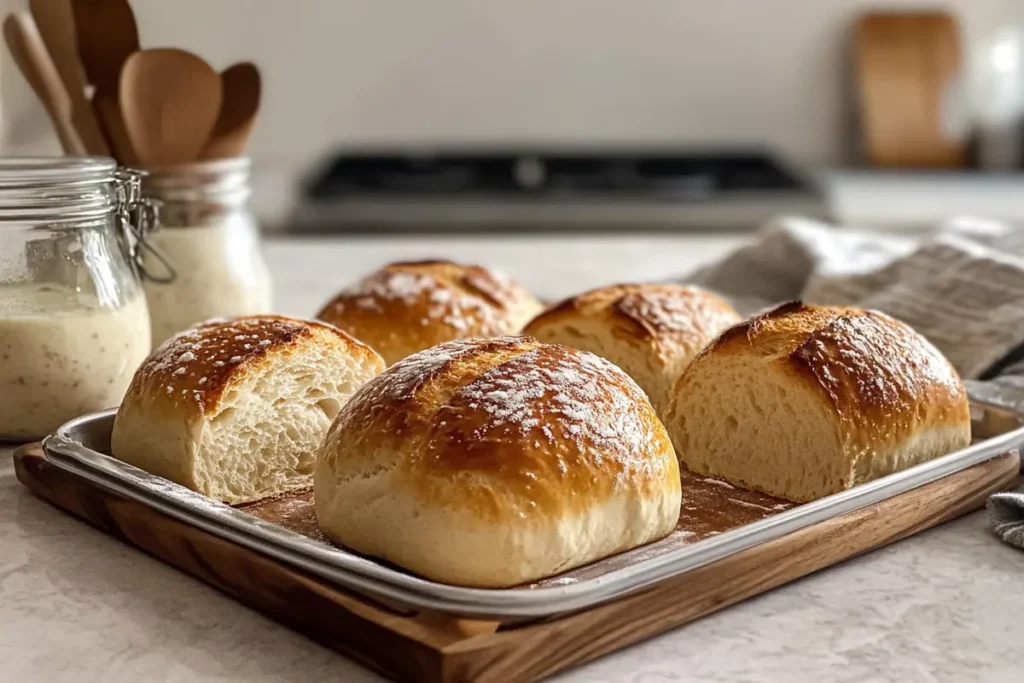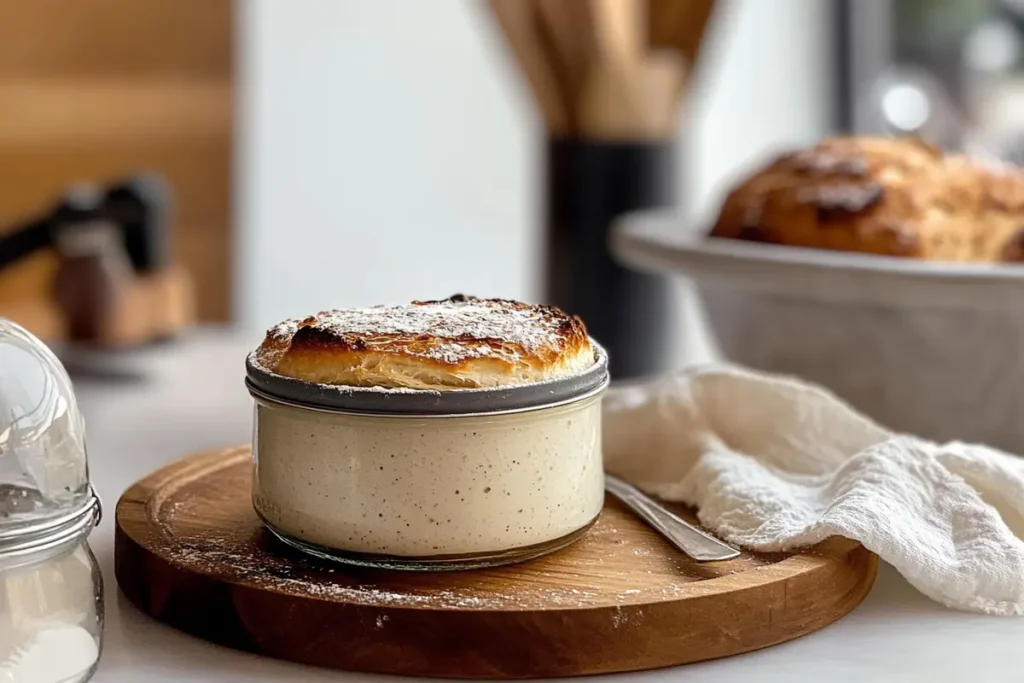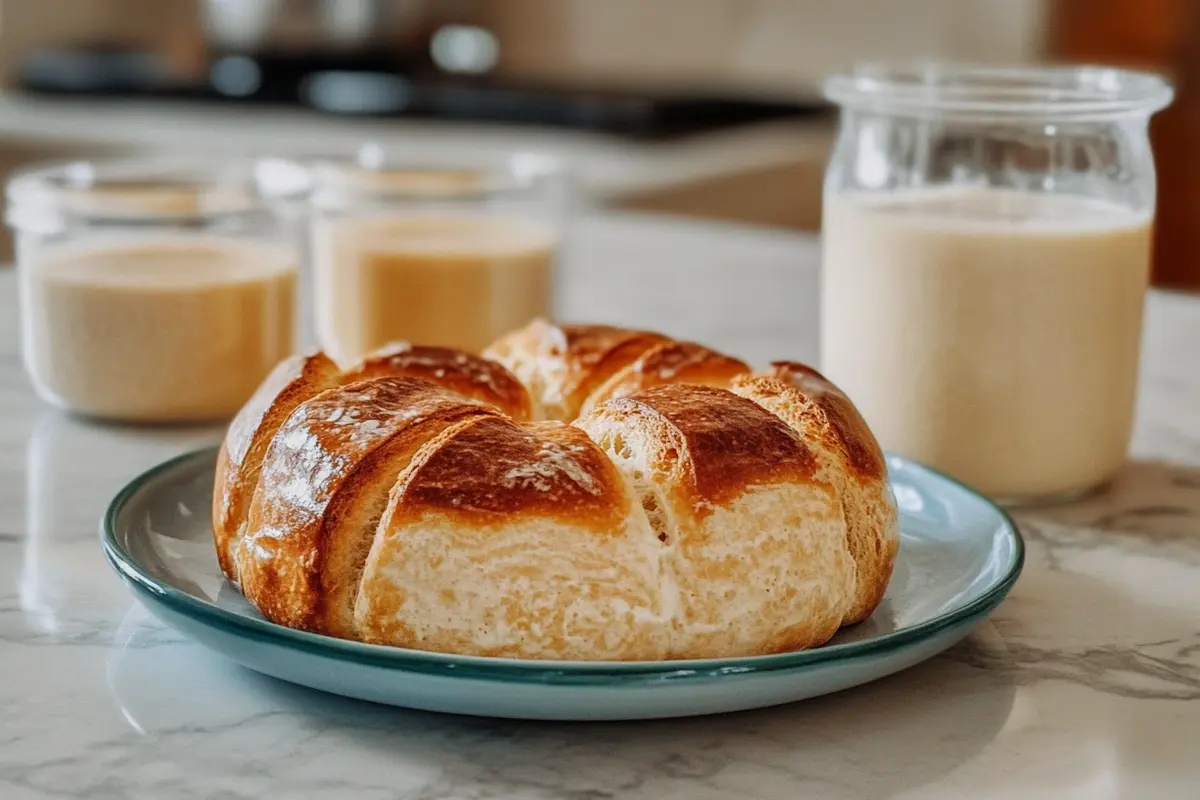Is sourdough good for desserts? This article explores the surprising ways sourdough can enhance sweet treats. It covers everything from flavor to texture and provides tips for using it in desserts.
The Intriguing Question: Is Sourdough Good for Desserts?
The question, is sourdough good for desserts?, often surprises people. We typically associate sourdough with savory breads. However, its unique flavor and texture can enhance many sweet treats. Sourdough’s slightly tangy taste offers a lovely contrast to sweetness. It adds complexity to desserts, making them more interesting. Therefore, sourdough might be the secret ingredient you’ve been missing in your baking. Moreover, its natural fermentation process brings an extra layer of depth.
Understanding Sourdough Flavor and Its Impact
Sourdough gets its distinctive tang from fermentation. This process creates lactic and acetic acids, providing a complex flavor profile. Furthermore, this flavor can vary based on the starter’s age and feeding schedule. This tanginess, while present, doesn’t overwhelm sweet flavors. Instead, it compliments them, creating a more layered taste experience. For example, consider how citrus notes can brighten up a dessert; sourdough does something similar. Therefore, using sourdough can elevate your desserts in an unexpected way. In addition, the fermentation creates unique byproducts that enhance aroma as well.
Texture Matters: How Sourdough Affects Dessert
Sourdough not only influences flavor but also impacts texture. The fermentation process creates air pockets, leading to a lighter, more airy crumb. Additionally, when used in desserts, this can result in a softer, more tender product. For example, sourdough pancakes become delightfully fluffy. Moreover, the slight chewiness of sourdough can also add a pleasant contrast to creamy fillings. Therefore, the texture benefits are another reason to explore sourdough in desserts. The added air pockets also improve the overall mouthfeel.
Sourdough Starter: The Key to Dessert Success
The sourdough starter is the heart of sourdough baking. Indeed, a healthy and active starter is crucial for successful results in desserts. Furthermore, using a well-established starter will yield the best flavor and texture. It is always better to feed your starter regularly, to ensure it’s at its peak when baking. Consequently, paying attention to your starter is the first step in using sourdough for delightful desserts. Maintaining your starter’s health becomes even more important for delicate desserts.
Sourdough Dessert Ideas: What to Bake
Now that you know sourdough is good for desserts, let’s look at some ideas. These treats highlight the amazing versatility of sourdough in sweet applications. Sourdough’s unique properties can enhance classic desserts. Moreover, you’ll find that sourdough adds a touch of sophistication.

Sourdough Pancakes and Waffles: A Classic Twist
Starting with breakfast, sourdough pancakes and waffles are excellent options. The slight tang of sourdough balances the sweetness. In addition, the fermentation process makes them lighter and fluffier. Because of this, they are a much better option than regular recipes. Sourdough gives pancakes a unique flavor boost, that you will love. Therefore, consider swapping your regular batter for a sourdough version. Also, you can use a variety of toppings with sourdough pancakes.
Sourdough Chocolate Cake: A Rich Treat
Sourdough can even be used in chocolate cake. The acidity in sourdough enhances the cocoa flavors. This leads to a deeper, richer chocolate taste. Moreover, the sourdough contributes a tender, moist crumb to the cake. For example, a sourdough chocolate cake will have a more complex profile. Consequently, this makes it far more interesting than other cakes. Therefore, using sourdough in chocolate cake is a surprising but successful move. Sourdough can transform a standard cake into something quite special.
Sourdough Brownies: Chewy and Delicious
Adding sourdough to brownies creates a deliciously chewy texture. Additionally, it adds a subtle tang that compliments the chocolate flavor perfectly. Moreover, the sourdough also contributes to a fudgier interior. Because of this, sourdough brownies become an irresistible treat. Therefore, consider sourdough for your next brownie batch. The slightly chewy texture is a delightful surprise for many.
Sourdough Cinnamon Rolls: A Flavorful Swirl
Sourdough cinnamon rolls are another excellent sourdough dessert option. Furthermore, the sourdough gives the dough a slightly tangy flavor. This contrasts nicely with the sweet cinnamon filling. Also, the sourdough creates a lighter and more airy roll. For example, the fermentation results in a soft, fluffy texture. Therefore, using sourdough in cinnamon rolls creates an elevated experience. This method gives the dough a superior, more satisfying structure.
Sourdough Fruit Cobblers: A Rustic Delight
Sourdough can be a great base for fruit cobblers. Its subtle tang compliments the sweetness of the fruit. Moreover, the crust becomes wonderfully crisp and chewy. Sourdough gives cobblers a rustic, homemade quality. For example, the slight acidity enhances the flavors of berries or apples. Therefore, sourdough is a good option for fruit cobblers. Its natural qualities enhance the fruit’s natural sweetness.
Sourdough Donuts: A Unique Treat
Sourdough donuts offer a pleasant twist on a classic treat. The sourdough adds a subtle tang, creating a well-balanced flavor. In addition, the dough is soft and airy, not dense or greasy. For example, sourdough glazed donuts are an exciting alternative. Therefore, trying sourdough for donuts is a good choice for bakers. This is another great example of sourdough’s versatility.
Sourdough Cookies: A Chewy Surprise
Sourdough can also make wonderful cookies. It contributes a nice chewiness and a subtle tang. This compliments flavors like chocolate chips, nuts, and spices. The texture, thanks to the sourdough, is a pleasant surprise. Therefore, sourdough cookies offer something unique. You can make many types, from classic chocolate chip to oatmeal raisin.
Sourdough in Various Dessert Formats: Flexibility
Sourdough is surprisingly flexible in the dessert world. You can use it in various forms, each providing unique benefits. The possibilities extend beyond the basic recipes. This flexibility allows you to get creative with your baking. Moreover, it invites you to try different flavor combinations.

Sourdough Discard: No Waste Baking
One of the best things about sourdough is how versatile the discard is. Sourdough discard can be used to make many different desserts. Therefore, no portion of your starter goes to waste. You can use it for pancakes, waffles, and even cake. This also reduces waste and allows you to experiment with flavor profiles. Indeed, using discard is a great idea. For instance, sourdough discard cookies are always a good choice. It’s a great way to be both eco-friendly and a resourceful baker.
Sourdough for Different Sweet Doughs
Sourdough can be incorporated into various sweet doughs, such as brioche. Sourdough adds a nice tang to these rich doughs. This creates a flavor that is both comforting and complex. Furthermore, the sourdough gives the dough a wonderful texture. For example, consider a sourdough brioche donut. Therefore, sourdough elevates the taste of sweet doughs. This allows you to explore new flavors and combinations.
Sourdough as a Flavor Enhancer
Even small amounts of sourdough can act as a flavor enhancer. Adding a bit of sourdough starter to any sweet batter can add a subtle tang. This small addition compliments the other flavors perfectly. It creates a more interesting and complex dessert. Sourdough can make even simple desserts taste special. Therefore, consider using sourdough for an additional taste boost. This will always elevate the final product and impress those trying it.
Sourdough and Different Flours
Sourdough works well with many types of flour. You can create different flavors by using whole wheat or rye. The sourdough will ferment those flours differently, changing the final flavor. Therefore, trying different flours will lead to unique desserts. For example, sourdough buckwheat pancakes offer a nutty flavor. Indeed, experimenting with flours is worthwhile. Each type of flour will react differently with the sourdough.
Sourdough Crepes: A Delicate Treat
Sourdough crepes are a delightful option for a delicate treat. The slightly tangy flavor compliments the fillings you choose. Sourdough gives the crepes a light, airy texture. For example, they can be filled with fresh fruit and cream. Therefore, consider sourdough for your next crepe recipe. The texture is wonderfully light and airy.
Sourdough Pie Crust: A Flaky Base
Using sourdough in pie crust creates a flaky and flavorful base. The fermentation process adds depth to the flavor. Additionally, the crust develops a nice chewiness. Sourdough pie crust compliments both sweet and savory fillings. Therefore, sourdough pie crust is worth exploring. It adds a touch of artisanal quality to your baking.
Troubleshooting and Tips for Sourdough Desserts
Using sourdough for desserts may be a little different than traditional baking. Understanding common issues and knowing how to solve them is important. Here are a few tips to help. Moreover, there are several nuances to using sourdough that are worth exploring.
Managing Sourdough’s Acidity
The level of tang can vary in sourdough. To control it, you can adjust the fermentation time. A longer ferment means a more tangy flavor. Therefore, if you want a milder flavor, use a shorter fermentation time. Also, be sure your starter is not too acidic before baking. Accordingly, a healthy starter is key to the correct flavor. Monitoring your starter’s health is therefore important for successful results.
Adjusting Sweetness in Sourdough Desserts
The tang of sourdough might require some adjustment in sweetness. Consequently, you may need to add a little more sweetener. Always start with the amount stated in the recipe, and adjust to taste. Therefore, it is important to taste your batter as you go. Additionally, using good quality sweeteners will help the flavor. Choosing a sweetener that pairs well with the flavor of sourdough is also recommended.
Sourdough Consistency: Getting It Right
Getting the consistency of your sourdough batter right is important. If the batter is too thick, add more liquid. If it’s too thin, add a little more flour. Always add gradually. For example, the dough should be smooth and pourable. Therefore, it is necessary to adjust the consistency correctly. It is a delicate balance between too thick and too thin.
Baking Times and Temperatures: Key Factors
Baking sourdough desserts may require slight adjustments to the usual time and heat. Since sourdough has different characteristics, it’s good to keep an eye on the baking process. For example, you might need to lower the heat a little. Also, you may need to bake for a bit longer. Therefore, always follow the recipe instructions and adjust as needed. Using a thermometer can help ensure your baked goods are cooked properly.
The Role of Proofing in Sourdough Desserts
Proofing is essential in sourdough baking. It is the process where the dough rises due to fermentation. It is good to ensure your dough is adequately proofed before baking. Under-proofing can result in a dense dessert. Over-proofing can cause the dough to collapse. Therefore, observe the dough closely and adjust the proofing time as needed. The environment can also impact how the dough proofs.
Understanding Hydration in Sourdough Baking
Hydration, the water content in your dough, is another important element to understand. The correct hydration will impact the texture of your desserts. If the dough is too dry, it will be stiff and not rise well. If it’s too wet, it will be hard to shape. Therefore, pay attention to the hydration levels in your sourdough recipe. Adjusting these levels might be necessary based on different flours.
Conclusion: Embrace the Sweet Side of Sourdough
In conclusion, sourdough is indeed good for desserts. Its unique flavor profile and textural contributions make it a valuable addition to any baker’s repertoire. The subtle tang compliments sweetness, creating more complex and interesting flavors. From fluffy pancakes to decadent cakes, sourdough adds a special touch. Therefore, don’t hesitate to explore the sweet side of sourdough. Embrace the versatility and elevate your desserts to new heights. The world of sourdough desserts is vast and ready for you to explore. Experiment and enjoy the journey of creating amazing sourdough treats.
Frequently Asked Questions (FAQs)
What is sourdough bread best for?
Sourdough bread is best for those who love complex flavor and good texture. It is good for sandwiches, toast, and side dishes. Its subtle tanginess makes it versatile. The sourdough enhances the flavor of many meals.
What not to do with sourdough?
Do not use a sourdough starter that is too sour. Avoid over-proofing your dough. Don’t use very cold ingredients directly from the fridge. Sourdough needs time and gentle handling. Therefore, be patient and use high-quality ingredients.
Can sourdough taste sweet?
Yes, sourdough can taste sweet. While sourdough has a tangy taste, adding sugars creates a balance. Moreover, the tanginess can compliment sweet flavors. Therefore, sourdough can be a nice addition to desserts.
What is the biggest mistake you can make with your sourdough starter?
The biggest mistake is neglecting your starter. For instance, not feeding it regularly. Also, not storing it properly. A neglected starter can become unusable. Therefore, care for your starter to have good baking results.

